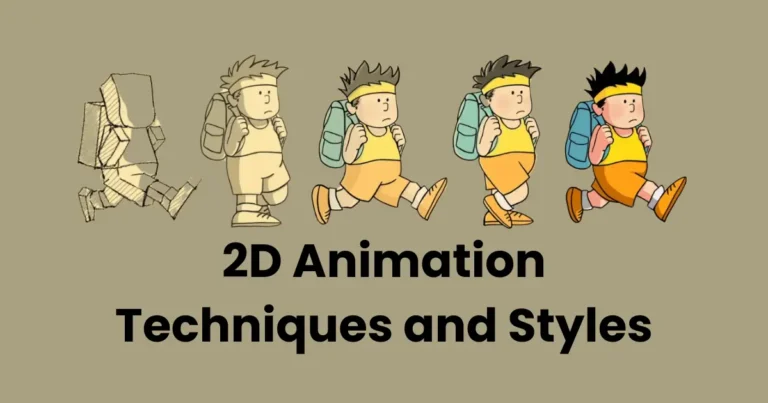How Much Does An Animator Make? | Animator’s Earning With Best Tips In 2025

Contents
- 1 Factors That Influence an Animator’s Earnings
- 2 Average Animator Salaries: How much does an animator make Worldwide
- 3 Earnings Based on Animation Specialization
- 4 How much does an animator make through Freelancing
- 5 Tips to Maximize Your Earnings as an Animator
- 5.1 1. Upskill and Stay Updated
- 5.2 2. Build a Strong Portfolio
- 5.3 3. Network Effectively
- 5.4 4. Specialize in a Niche
- 5.5 5. Leverage Freelancing Platforms
- 5.6 6. Negotiate Contracts Wisely
- 5.7 7. Diversify Your Income Streams
- 5.8 8. Work on High-Profile Projects
- 5.9 9. Improve Your Soft Skills
- 5.10 10. Stay Ahead of Trends
- 6 Future of Animation: What It Means for Animator Salaries
- 6.0.1 1. Emerging Technologies and Their Impact on Salaries
- 6.0.2 2. Expansion into New Industries
- 6.0.3 3. Increasing Globalization of Animation Projects
- 6.0.4 4. Demand for Personalized Content
- 6.0.5 5. Increasing Need for Diverse Skill Sets
- 6.0.6 6. Project-Based Compensation Trends
- 6.0.7 7. Regional Shifts in Animation Hubs
- 6.1 Conclusion
Animation is no longer confined to the world of cartoons and feature films. Today, animators play a vital role in industries ranging from video games and advertising to virtual reality and education. With the global demand for visual storytelling on the rise, animation has become one of the most dynamic and sought-after career paths.
But just how much does an animator make? The answer depends on various factors, such as expertise, location, industry, and the nature of the job. Whether you’re considering a full-time position with a studio or embarking on a freelance journey, understanding the financial prospects of animation can help you make informed career decisions. This article explores the factors that influence animator salaries, compares earnings across specializations and regions, and provides tips on how to maximize your income in this exciting and evolving field. Let’s dive in to discover if animation can be as rewarding financially as it is creatively.
Factors That Influence an Animator’s Earnings
An animator’s income can vary significantly based on multiple factors. Whether you’re just starting your career or are an experienced professional, understanding these elements can help you position yourself for better financial opportunities.
1. Experience and Expertise
Experience is one of the most critical determinants of how much an animator can earn.
- Entry-level animators: Typically earn lower salaries as they focus on building their portfolio and gaining practical skills.
- Mid-Level Animators: With several years of experience, animators often command higher pay as their skills become more refined and their ability to deliver complex projects improves.
- Senior or Specialized Animators: Industry veterans or those with expertise in niche areas like motion capture or character rigging can earn significantly higher wages.
2. Geographic Location
Where you work plays a significant role in your earnings.
- High-Paying Regions: Countries like the United States, Canada, and the United Kingdom tend to offer higher salaries, especially in cities like Los Angeles, Vancouver, and London, which are hubs for the animation industry.
- Lower-Paying Regions: In contrast, animators in developing countries may earn less, although the cost of living in these areas often balances out the disparity.
3. Industry and Specialization
Different industries require varying levels of animation expertise, influencing salary potential.
- Film and TV: These industries often pay more, especially for high-budget productions.
- Gaming: Game animation is another lucrative field, especially for animators skilled in creating immersive 3D environments and character movements.
- Advertising and Marketing: These industries also offer competitive pay, especially for short, high-quality animated campaigns.
4. Freelance vs. Full-Time Positions
The nature of your employment—whether freelance or full-time—significantly impacts your income.
- Freelancers: Have the flexibility to set their rates and potentially earn more, but they face income variability and a lack of benefits like health insurance or paid leave.
- Full-Time Employees: Benefit from steady income, job security, and additional perks, but their earning potential may be capped by company budgets.
5. Portfolio and Reputation
A strong portfolio showcasing your best work can significantly impact how much clients or employers are willing to pay. Animators with well-known projects or a reputation for excellence often command premium rates.
6. Technology and Tools Proficiency
Being proficient in industry-standard tools such as Maya, Blender, or Unity can boost your earning potential. Staying updated with the latest software and techniques, such as AI-powered animation tools, can give you a competitive edge in the job market.
By understanding these factors, animators can strategize their career paths to maximize their earning potential while continuing to grow creatively.
Average Animator Salaries: How much does an animator make Worldwide
Animator salaries vary widely across the globe, influenced by factors such as local demand, industry standards, and the cost of living in different regions. Below is an overview of animator earnings across key regions:

1. North America
- United States:
- Entry-Level: $40,000–$60,000 per year
- Mid-Level: $65,000–$85,000 per year
- Senior-Level: $90,000–$120,000+ per year
- Key Locations: Los Angeles, New York, San Francisco
Animation is a highly lucrative career in the U.S., especially in hubs like Hollywood, which caters to the entertainment industry.
- Canada:
- Entry-Level: CAD 40,000–CAD 60,000 per year
- Mid-Level: CAD 65,000–CAD 85,000 per year
- Senior-Level: CAD 90,000–CAD 120,000+ per year
- Key Locations: Vancouver, Toronto, Montreal
Canada is a global hub for animation, particularly in gaming and film production.
2. Europe
- United Kingdom:
- Entry-Level: £20,000–£30,000 per year
- Mid-Level: £35,000–£50,000 per year
- Senior-Level: £60,000–£80,000+ per year
- Key Locations: London, Manchester, Bristol
The UK animation scene thrives in gaming, advertising, and TV production.
- Germany:
- Entry-Level: €30,000–€40,000 per year
- Mid-Level: €45,000–€60,000 per year
- Senior-Level: €70,000–€90,000+ per year
Germany’s focus on creative industries and advertising makes it an attractive location for animators.
- France:
- Entry-Level: €25,000–€35,000 per year
- Mid-Level: €40,000–€60,000 per year
- Senior-Level: €70,000–€90,000+ per year
- Key Location: Paris
France is known for its vibrant animation industry, especially in feature films and independent projects.
3. Asia
- India:
- Entry-Level: ₹250,000–₹400,000 per year
- Mid-Level: ₹500,000–₹800,000 per year
- Senior-Level: ₹900,000–₹1,500,000+ per year
India is a growing player in outsourcing animation services, offering cost-effective talent for global markets.
- Japan:
- Entry-Level: ¥2,000,000–¥3,500,000 per year
- Mid-Level: ¥4,000,000–¥6,000,000 per year
- Senior-Level: ¥7,000,000–¥10,000,000+ per year
- Key Locations: Tokyo, Osaka
Japan’s animation industry is legendary for its anime and gaming culture, although working hours can be intensive.
- China:
- Entry-Level: ¥100,000–¥150,000 per year
- Mid-Level: ¥160,000–¥250,000 per year
- Senior-Level: ¥300,000–¥500,000+ per year
With significant investments in gaming and visual effects, China’s animation sector is rapidly expanding.
4. Other Regions
- Australia:
- Entry-Level: AUD 50,000–AUD 65,000 per year
- Mid-Level: AUD 70,000–AUD 85,000 per year
- Senior-Level: AUD 90,000–AUD 120,000+ per year
- Key Locations: Sydney, Melbourne
Animation in Australia is thriving, particularly in advertising and independent films.
- Latin America:
- Brazil: BRL 30,000–BRL 70,000 per year
- Argentina: ARS 1,000,000–ARS 2,500,000 per year
Latin America has a growing animation scene, though salaries tend to be lower compared to North America and Europe.
Earnings Based on Animation Specialization
The field of animation encompasses various specializations, each with its own set of demands and earning potential. Here’s a breakdown of average earnings across popular animation specializations:
1. 2D Animation
- Overview: 2D animation involves creating characters, environments, and storylines in a flat, two-dimensional space, commonly used in TV shows, commercials, and independent films.
- Average Earnings:
- Entry-Level: $30,000–$50,000 per year
- Mid-Level: $50,000–$70,000 per year
- Senior-Level: $75,000–$100,000+ per year
- Factors Affecting Pay: While 2D animation is timeless, the shift toward 3D and digital mediums has slightly limited its earning potential in some regions.
2. 3D Animation
- Overview: 3D animation is widely used in film, gaming, virtual reality, and architectural visualization, offering more dynamic and realistic visuals than 2D.
- Average Earnings:
- Entry-Level: $40,000–$60,000 per year
- Mid-Level: $65,000–$85,000 per year
- Senior-Level: $90,000–$130,000+ per year
- Factors Affecting Pay: Proficiency in software like Maya, Blender, or Cinema 4D and experience in industries like gaming or film can significantly boost earning potential.
3. Game Animation
- Overview: Animators in the gaming industry create lifelike character movements, immersive environments, and engaging gameplay experiences.
- Average Earnings:
- Entry-Level: $50,000–$70,000 per year
- Mid-Level: $75,000–$100,000 per year
- Senior-Level: $110,000–$150,000+ per year
- Factors Affecting Pay: Specialization in motion capture or expertise in game engines like Unreal Engine and Unity often leads to higher salaries.
4. Film and TV Animation
- Overview: Working on animated films or TV series often involves high-stakes projects with substantial budgets, leading to competitive salaries.
- Average Earnings:
- Entry-Level: $40,000–$65,000 per year
- Mid-Level: $70,000–$100,000 per year
- Senior-Level: $110,000–$150,000+ per year
- Factors Affecting Pay: Animators involved in blockbuster projects or award-winning productions can command premium rates.
5. Visual Effects (VFX) Animation
- Overview: VFX animators create realistic simulations of explosions, weather effects, and other special effects for films, TV shows, and video games.
- Average Earnings:
- Entry-Level: $45,000–$65,000 per year
- Mid-Level: $70,000–$90,000 per year
- Senior-Level: $100,000–$140,000+ per year
- Factors Affecting Pay: Experience with software like Houdini or After Effects and a strong portfolio can lead to higher salaries.
6. Advertising and Marketing Animation
- Overview: Animators in advertising create short, high-quality animations for brands, ranging from explainer videos to social media campaigns.
- Average Earnings:
- Entry-Level: $35,000–$55,000 per year
- Mid-Level: $60,000–$80,000 per year
- Senior-Level: $85,000–$110,000+ per year
- Factors Affecting Pay: Animators skilled in creating visually appealing and engaging content for digital platforms often earn more.
7. Motion Graphics Animation
- Overview: Motion graphics focus on animated text, graphics, and logos, commonly used in corporate videos, presentations, and broadcasting.
- Average Earnings:
- Entry-Level: $40,000–$60,000 per year
- Mid-Level: $65,000–$85,000 per year
- Senior-Level: $90,000–$120,000+ per year
- Factors Affecting Pay: Expertise in Adobe After Effects or Cinema 4D can help motion graphic artists secure higher-paying projects.
8. Stop-Motion Animation
- Overview: A niche field, stop-motion involves manually manipulating objects to create frame-by-frame animations. It’s often used in independent films and commercials.
- Average Earnings:
- Entry-Level: $30,000–$50,000 per year
- Mid-Level: $55,000–$70,000 per year
- Senior-Level: $75,000–$100,000+ per year
- Factors Affecting Pay: As a highly specialized form of animation, professionals with expertise in this field are in demand, though opportunities are fewer compared to digital animation.
9. Medical and Scientific Animation
- Overview: This specialization involves creating detailed animations for medical training, scientific research, and product marketing in the healthcare industry.
- Average Earnings:
- Entry-Level: $50,000–$70,000 per year
- Mid-Level: $80,000–$100,000 per year
- Senior-Level: $110,000–$150,000+ per year
- Factors Affecting Pay: Medical animators often require knowledge of biology or anatomy, making them highly valued professionals.
Animators can explore these specializations based on their interests and skills, as each offers unique opportunities for creativity and financial growth.
How much does an animator make through Freelancing
Freelance animation is an increasingly popular career path that offers flexibility, creative freedom, and the potential for lucrative earnings. However, income for freelance animators varies widely based on experience, specialization, client base, and location. Here’s a detailed look at how much does an animator make and how to maximize their income.

1. Average Income of Freelance Animators
Freelance animators typically charge clients on a per-project, hourly, or daily rate basis. Here are general income ranges:
- Entry-Level Freelance Animators:
- Hourly Rate: $20–$40 per hour
- Annual Income: $20,000–$40,000
- Mid-Level Freelance Animators:
- Hourly Rate: $40–$75 per hour
- Annual Income: $50,000–$80,000
- Experienced/Specialized Freelance Animators:
- Hourly Rate: $80–$150+ per hour
- Annual Income: $90,000–$150,000+
Freelancers working with high-budget clients in industries like gaming, VFX, or advertising can earn significantly more. Rates can also increase for animators with unique skills or niche expertise, such as medical animation or VR content.
2. Factors Affecting Freelance Animator Income
- Skill Level and Specialization:
Freelancers with advanced skills in tools like Blender, Maya, or Unreal Engine, or those specializing in high-demand areas (e.g., 3D animation, game animation), can command higher rates. - Client Type and Budget:
Working with corporate clients or agencies often results in higher pay compared to independent creators or startups. - Project Scope and Complexity:
Simple 2D explainer videos may pay less than intricate 3D character animations or VFX projects. - Geographical Location:
Freelancers in regions with higher living costs, such as the U.S. or Western Europe, tend to charge more than those in developing countries.
3. Platforms and Marketplaces for Freelance Work
Freelancers often rely on online platforms to find clients. Each platform has different earning potential:
- Upwork: Rates range from $20 to $100 per hour, depending on experience and client type.
- Fiverr: Freelancers can earn $300–$5,000+ per project, especially for specialized services like logo animation or character design.
- Freelancer.com: Offers diverse projects with budgets ranging from $500 to $10,000.
- Behance and Dribble: Primarily portfolio sites, these platforms attract high-budget clients willing to pay premium rates.
- Direct Networking: Freelancers with strong networks can bypass platforms, avoiding fees and often negotiating higher rates directly.
4. Income by Specialization
Certain types of animation yield higher freelance incomes:
- Explainer Video Animation: $500–$5,000 per project
- 3D Animation for Games or VR: $2,000–$20,000+ per project
- Medical or Scientific Animation: $3,000–$15,000+ per project
- VFX and Motion Graphics: $2,000–$10,000 per project
Specialized freelancers often set higher rates due to the advanced skills and expertise required.
5. Strategies to Maximize Freelance Animator Income
- Set Competitive Rates: Research market trends and don’t undervalue your work. Adjust rates as you gain experience and build a reputation.
- Diversify Income Streams: Explore passive income options like selling stock animations, creating online courses, or licensing work to multiple clients.
- Build a Strong Portfolio: Showcase a range of high-quality projects tailored to your target clientele.
- Leverage Social Media and Networking: Promote your work on platforms like LinkedIn, Instagram, or Twitter to attract high-paying clients.
- Offer Package Deals: Bundle services such as storyboarding, animation, and editing to increase project value.
6. Challenges and Opportunities
Challenges:
- Irregular Income: Freelancers may face periods of low demand or delayed payments.
- Client Management: Negotiating contracts, managing revisions, and ensuring timely payments can be time-consuming.
- Competition: Online platforms often have stiff competition, especially from low-cost providers.
Opportunities:
- Global Reach: Freelancers can work with clients worldwide, accessing markets with higher-paying opportunities.
- Creative Freedom: Freelancers can choose projects that align with their interests and artistic style.
- Growing Demand: Industries like gaming, advertising, and education are increasingly outsourcing animation work, creating new opportunities.
Freelancing as an animator offers unlimited earning potential for those who are skilled, proactive, and business-savvy. By developing expertise, maintaining a strong online presence, and consistently delivering quality work, freelance animators can thrive in this flexible and dynamic career path.
Tips to Maximize Your Earnings as an Animator
In the competitive field of animation, maximizing your earnings requires strategic planning, constant learning, and leveraging your skills effectively. Here are actionable tips to help you boost your income as an animator:

1. Upskill and Stay Updated
The animation industry is constantly evolving with new tools and techniques.
- Learn Industry-Standard Software: Master programs like Maya, Blender, Cinema 4D, and After Effects.
- Explore Emerging Technologies: Gain expertise in virtual reality (VR), augmented reality (AR), and AI-powered animation tools, as these skills are in high demand.
- Invest in Certifications: Professional courses and certifications can enhance your credibility and open doors to higher-paying roles.
2. Build a Strong Portfolio
A well-crafted portfolio is your gateway to better opportunities.
- Highlight Your Best Work: Include diverse projects that showcase your technical skills and creativity.
- Tailor Your Portfolio: Adapt your portfolio to target specific industries, such as gaming, advertising, or VFX.
- Update Regularly: Refresh your portfolio with recent projects to demonstrate your current capabilities.
3. Network Effectively
Connections are crucial in the animation industry.
- Join Industry Events: Attend animation expos, workshops, and film festivals to meet potential clients and employers.
- Engage on Social Media: Platforms like LinkedIn, Behance, and Instagram are excellent for showcasing your work and connecting with professionals.
- Collaborate with Peers: Working on joint projects can increase exposure and lead to referrals.
4. Specialize in a Niche
Focusing on a specific area of animation can help you stand out and command higher rates.
- High-Demand Niches: Consider specializations like 3D character animation, game design, or medical animation.
- Become an Expert: The deeper your expertise in a niche, the more you can charge for your services.
5. Leverage Freelancing Platforms
Freelancing can significantly increase your income if managed effectively.
- Join Platforms: Use websites like Upwork, Fiverr, or Freelancer to find clients.
- Set Competitive Rates: Research market trends to set rates that reflect your experience and skills.
- Build a Reputation: Deliver high-quality work and earn positive reviews to attract premium clients.
6. Negotiate Contracts Wisely
Negotiation is key to earning what you’re worth.
- Understand Your Value: Research average salaries or freelance rates for your skill level and location.
- Highlight Your Expertise: Emphasize your unique skills and experience during negotiations.
- Offer Package Deals: For freelancing, bundling services like animation, editing, and storyboarding can justify higher fees.
7. Diversify Your Income Streams
Having multiple sources of income can boost your overall earnings.
- Create Online Tutorials: Share your knowledge on platforms like YouTube or sell courses on Udemy.
- Sell Assets: Offer stock animations, templates, or 3D models on marketplaces like Gumroad or TurboSquid.
- Explore Passive Income: Licensing your animations or working on royalty-based projects can provide steady income over time.
8. Work on High-Profile Projects
Experience with high-profile or award-winning projects can elevate your career.
- Target Large Studios: Companies like Pixar, Disney, or major game developers offer competitive pay and prestige.
- Focus on Quality Over Quantity: Taking on fewer, higher-paying projects can be more rewarding than juggling multiple low-paying gigs.
9. Improve Your Soft Skills
Technical expertise is crucial, but soft skills can set you apart.
- Communicate Clearly: Be professional and responsive in your interactions with clients or employers.
- Manage Time Effectively: Delivering work on schedule can enhance your reputation and lead to repeat business.
- Be Adaptable: Flexibility in incorporating feedback ensures client satisfaction.
10. Stay Ahead of Trends
Understanding market trends can give you a competitive edge.
- Research Industry Needs: Keep an eye on what’s popular in gaming, advertising, or entertainment.
- Experiment with New Styles: Clients often seek fresh and innovative animation styles.
- Stay Curious: Regularly explore new techniques, genres, and storytelling methods to remain relevant.
By adopting these strategies, you can enhance your skills, reputation, and marketability, ensuring a steady increase in your earnings while enjoying a fulfilling career in animation.
Future of Animation: What It Means for Animator Salaries
The animation industry is rapidly evolving, driven by technological advancements, new market demands, and an increasing reliance on visual storytelling across sectors. These changes not only shape the creative landscape but also have a direct impact on animator salaries. Here’s what the future of animation holds and how it might affect earning potential:

1. Emerging Technologies and Their Impact on Salaries
- Virtual Reality (VR) and Augmented Reality (AR):
VR and AR applications are growing in gaming, education, healthcare, and retail. Animators skilled in creating immersive VR/AR experiences are likely to command premium salaries due to the high demand for these niche skills. - Artificial Intelligence (AI):
While AI tools are making some animation processes more efficient, they also create opportunities for animators who can integrate AI-powered features into their work, such as procedural animations and motion capture enhancements. - Real-Time Animation:
Game engines like Unreal Engine and Unity are driving real-time rendering in industries beyond gaming, including film and virtual production. Animators adept at using these tools will find themselves in high demand.
2. Expansion into New Industries
Animation is no longer limited to entertainment; it’s becoming integral in other fields:
- Healthcare and Education:
Medical and educational animation is growing rapidly, offering animators opportunities in highly specialized fields with higher-than-average salaries. - Marketing and Advertising:
Businesses increasingly use animation for social media campaigns, explainer videos, and interactive content, leading to more job opportunities for animators in corporate sectors. - E-Learning and Training:
With the rise of online education, animated content for e-learning platforms is expected to grow, creating steady demand for skilled animators.
3. Increasing Globalization of Animation Projects
- Outsourcing and Collaboration:
Studios are increasingly outsourcing animation work to global teams. While this may lower salaries in some regions, animators in high-demand niches or with unique skills can still negotiate competitive rates. - Remote Work Opportunities:
The shift to remote work has allowed animators to take on projects worldwide, enabling skilled professionals to access better-paying jobs regardless of location.
4. Demand for Personalized Content
As consumers seek personalized and interactive experiences, animators with storytelling expertise will be in high demand.
- Interactive Media:
The rise of interactive videos, gaming, and personalized digital content offers lucrative opportunities for animators who can adapt their skills to meet these needs. - Custom Animation:
Brands are increasingly investing in custom animations to differentiate themselves, leading to higher budgets and better salaries for skilled professionals.
5. Increasing Need for Diverse Skill Sets
The future animator will need a combination of technical, creative, and industry-specific skills:
- Hybrid Roles:
Studios seek animators who can handle multiple aspects of production, such as modeling, rigging, and animation, which can lead to higher pay. - Continuous Learning:
Animators who keep up with emerging tools and trends, such as NFT-based animations or procedural generation, will stay competitive and earn more.
6. Project-Based Compensation Trends
- Short-Term, High-Paying Projects:
Studios are increasingly hiring freelancers for specific projects, enabling animators to negotiate higher rates based on their specialized skills. - Royalties and Licensing:
Animators may benefit from earning royalties or licensing fees for their work, especially in gaming and film industries where recurring revenue is common.
7. Regional Shifts in Animation Hubs
New animation hubs are emerging globally, influencing salary trends:
- Asia:
Countries like India, China, and Japan are seeing significant growth in their animation industries, with higher wages for experienced professionals. - Europe:
Smaller European countries, alongside major hubs like the UK and Germany, are becoming more competitive, offering better salaries to attract international talent.
Conclusion
The field of animation offers diverse career paths and income opportunities, with earnings largely influenced by factors such as specialization, experience, location, and industry demand. Whether you choose to work in 3D animation, game design, or as a freelance animator, the potential for financial growth is significant, especially for those who stay updated with emerging trends and technologies. The ability to adapt to advancements like AI-driven animation, virtual reality, and real-time rendering can open doors to high-paying roles, ensuring a competitive edge in this ever-evolving industry.
As an animator, your earning potential is not only shaped by technical expertise but also by strategic choices, such as building a strong portfolio, networking effectively, and diversifying your skill set. Whether you are working as a salaried professional or a freelance animator, opportunities abound in industries like gaming, advertising, healthcare, and education. By leveraging your unique skills and staying ahead of industry trends, you can maximize your income and achieve a successful and fulfilling career in animation.






